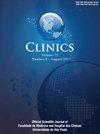腹膜透析患者抑郁的危险因素分析及风险图模型的建立
IF 2.4
4区 医学
Q2 MEDICINE, GENERAL & INTERNAL
引用次数: 0
摘要
目的分析腹膜透析患者抑郁的危险因素,并建立一种评估这些风险的预测图模型。方法选取2021年8月至2023年12月接受腹膜透析治疗的患者326例作为训练集。这些患者根据是否存在抑郁症被分为非抑郁组(229例)和抑郁组(97例)。另外,选取同期腹膜透析患者104例作为验证组。收集所有患者的临床资料进行分析。结果与非抑郁组相比,抑郁组女性患者、非就业人群、人均月收入2000元人群、心脑血管并发症和睡眠障碍比例较高。此外,抑郁组的血红蛋白和血尿酸水平低于非抑郁组(p <;0.05)。性别、工作状态、人均月收入、心脑血管并发症和睡眠障碍是腹膜透析患者抑郁的危险因素(p <;0.05),血红蛋白和血尿酸是腹膜透析患者抑郁的保护因素(p <;0.05)。校正曲线分析结果表明,预测概率与实际发病率基本一致。决策曲线分析(Decision Curve Analysis, DCA)结果表明,本研究建立的nomogram模型具有较强的临床适用性。结论结合性别、工作状态、人均月收入、心脑血管并发症、睡眠障碍、血红蛋白水平、血尿酸水平等因素建立的预测腹膜透析患者抑郁的nomogram模型具有良好的校准性和辨别性。具有较高的临床适用性。本文章由计算机程序翻译,如有差异,请以英文原文为准。
Analysis of risk factors for depression in peritoneal dialysis patients and establishment of a risk nomogram model
Objective
This study aims to analyze the risk factors for depression in peritoneal dialysis patients and to develop a predictive nomogram model for assessing these risks.
Methods
A total of 326 peritoneal dialysis patients treated between August 2021 and December 2023 were selected as the training set. These patients were categorized into a non-depression group (229 cases) and a depression group (97 cases) based on the presence of depression. Additionally, 104 peritoneal dialysis patients from the same period were selected as the validation set. Clinical data were collected from all patients for analysis.
Results
The depression group had higher proportions of female patients, non-employed individuals, those with a per capita monthly income of <2000-yuan, cardiovascular complications, cerebrovascular complications, and sleep disorders compared to the non-depression group. Additionally, the levels of hemoglobin and blood uric acid were lower in the depression group than in the non-depression group (p < 0.05). Gender, work status, per capita monthly income, cardiovascular complications, cerebrovascular complications, and sleep disorders are risk factors for depression in peritoneal dialysis patients (p < 0.05), while hemoglobin and blood uric acid are protective factors for depression in peritoneal dialysis patients (p < 0.05). Calibration curve analysis results showed that the predicted probability was basically consistent with the actual incidence rate. The results of the Decision Curve Analysis (DCA) demonstrated that the nomogram model developed in this study has strong clinical applicability.
Conclusion
The nomogram model for predicting depression in peritoneal dialysis patients, which incorporates factors such as gender, work status, per capita monthly income, cardiovascular complications, cerebrovascular complications, sleep disorders, hemoglobin levels, and blood uric acid levels, demonstrates excellent calibration and discrimination. Additionally, it has high clinical applicability.
求助全文
通过发布文献求助,成功后即可免费获取论文全文。
去求助
来源期刊

Clinics
医学-医学:内科
CiteScore
4.10
自引率
3.70%
发文量
129
审稿时长
52 days
期刊介绍:
CLINICS is an electronic journal that publishes peer-reviewed articles in continuous flow, of interest to clinicians and researchers in the medical sciences. CLINICS complies with the policies of funding agencies which request or require deposition of the published articles that they fund into publicly available databases. CLINICS supports the position of the International Committee of Medical Journal Editors (ICMJE) on trial registration.
 求助内容:
求助内容: 应助结果提醒方式:
应助结果提醒方式:


